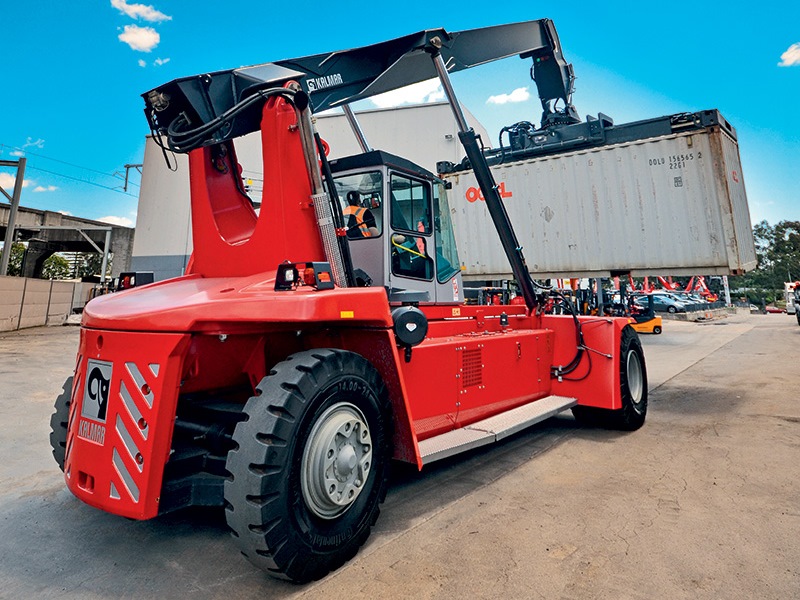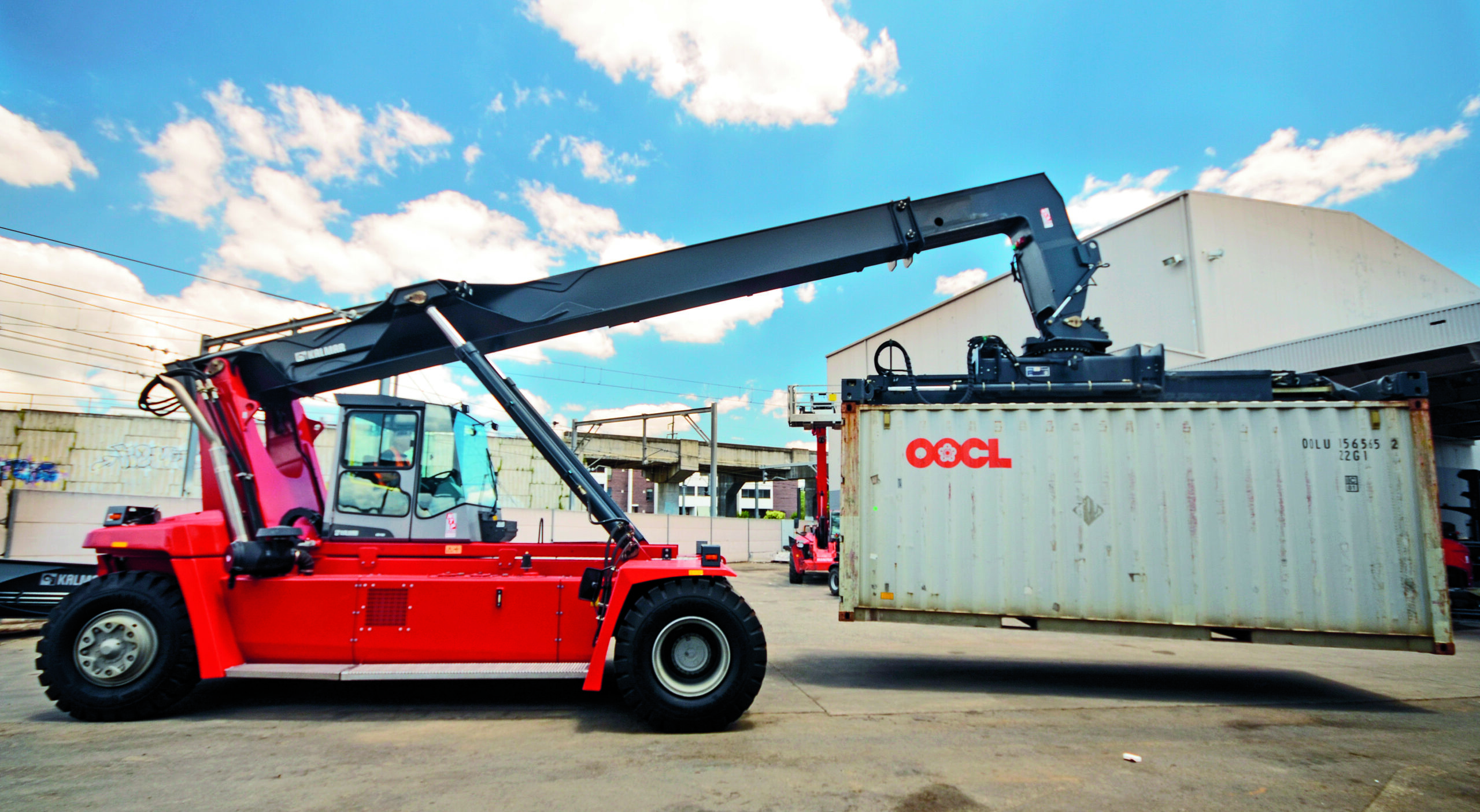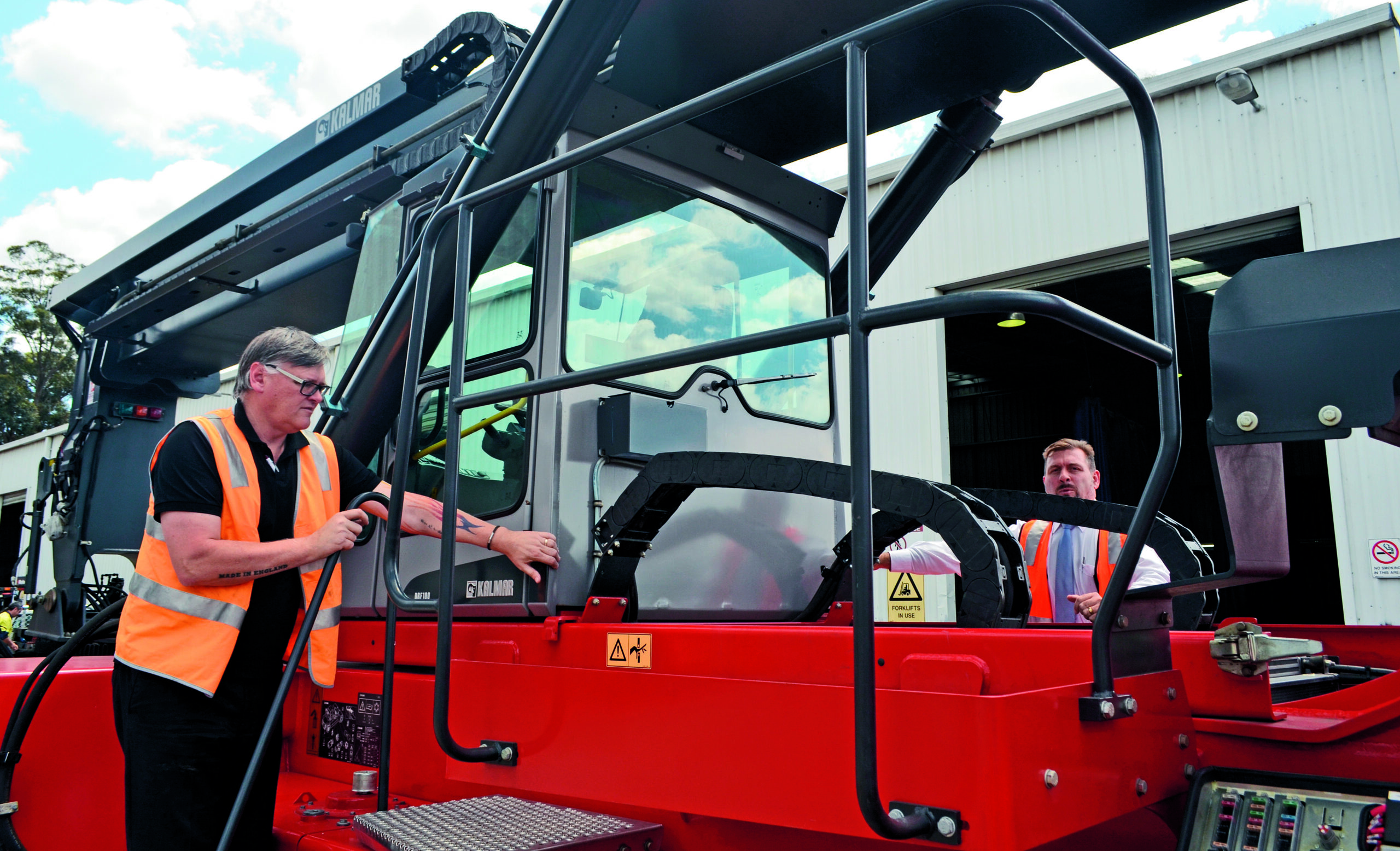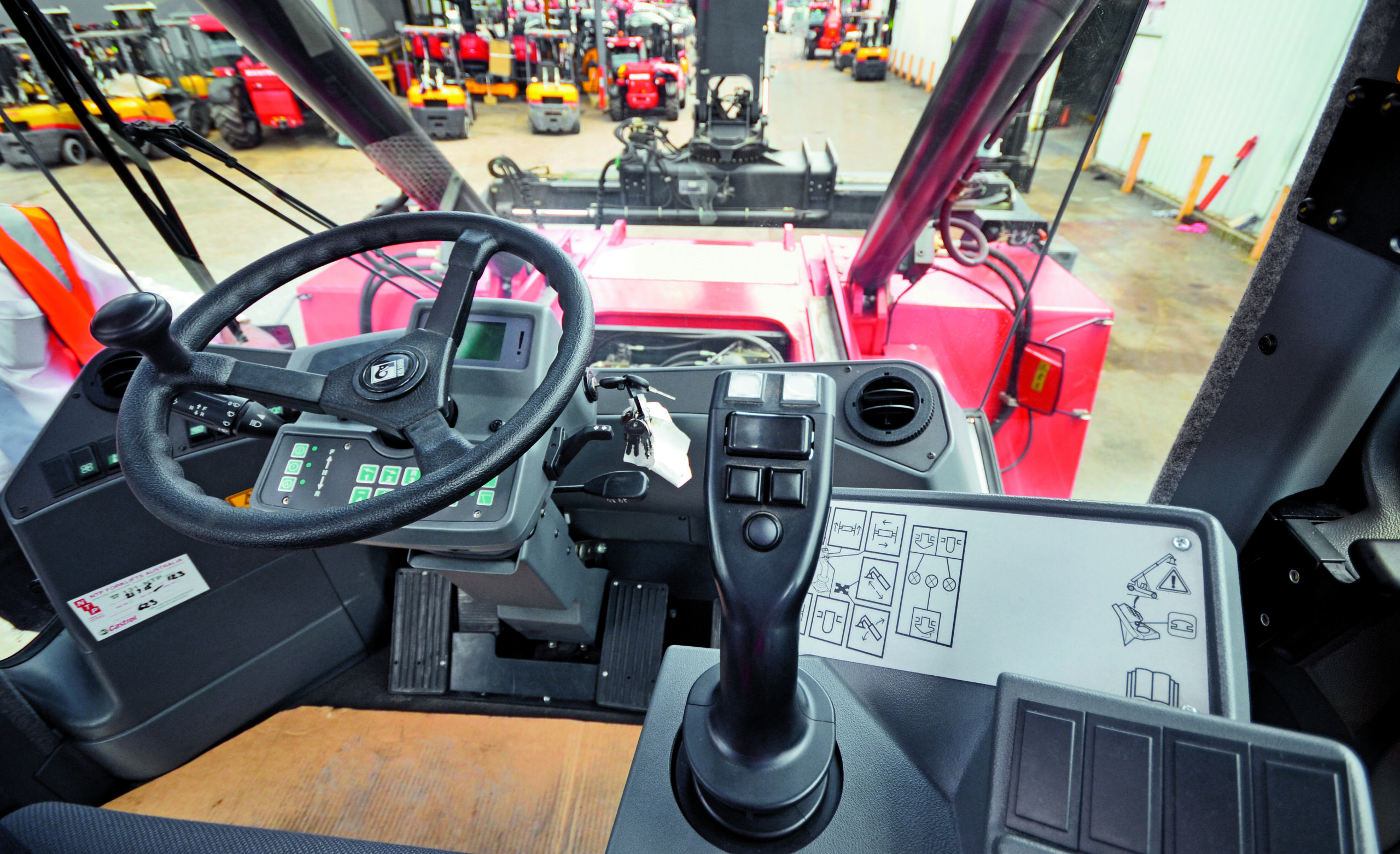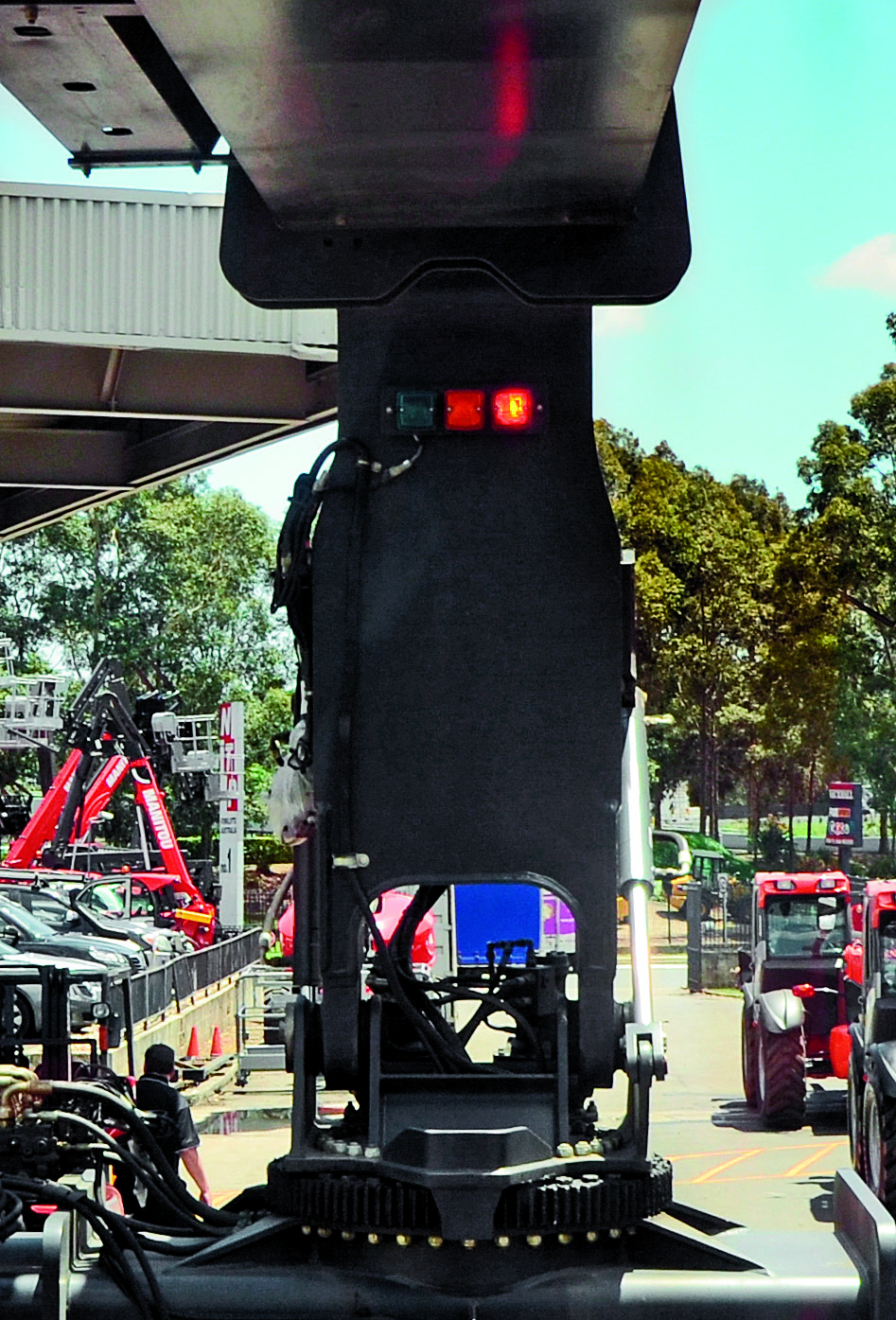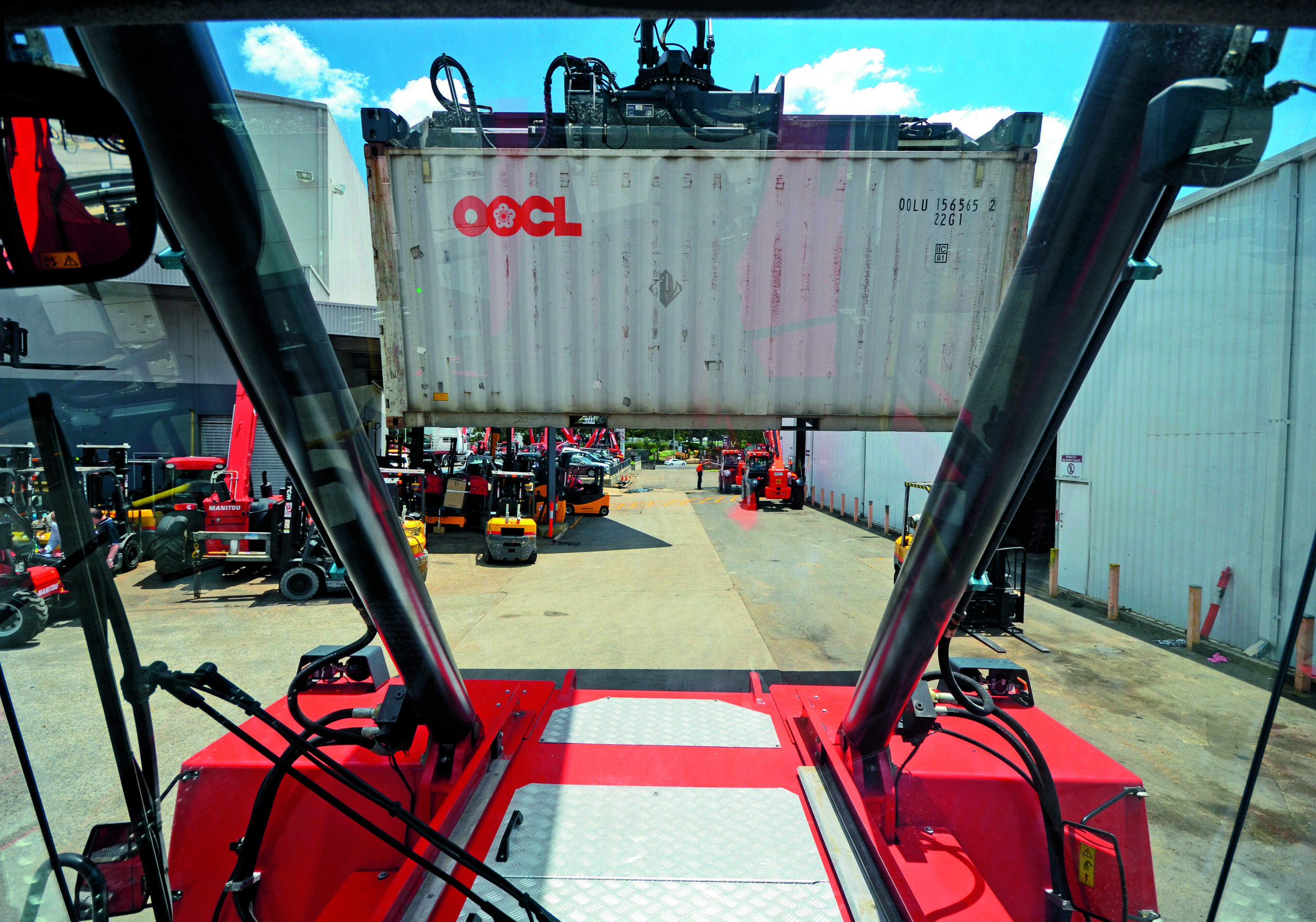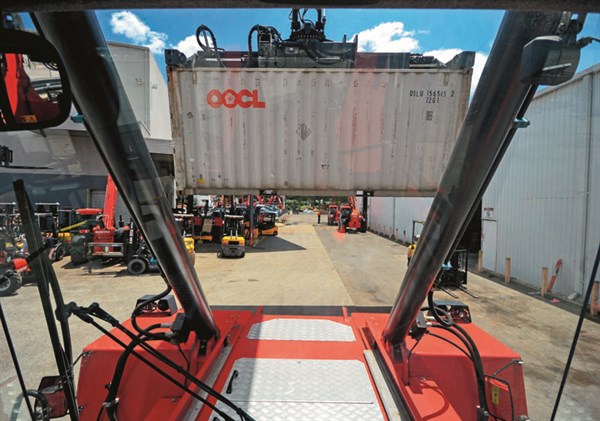The Swedish-made Kalmar DRF100 reach stacker takes some getting used to, but it may just steal your heart.
It’s as much about shifting attitudes as it is about shifting containers. Australia has always had an attachment to container handlers when it comes to moving laden or unladen containers.
Most operators grow up using forklifts, so the transition to a larger masted container handler was easily made. There was also the matter of cost, with heavy-duty reach stackers typically costing more than $100,000 above the price of a container handler.
Things could be on the turn, though, especially if Swedish giant Kalmar has anything to do with it.
The Kalmar DRF100 reach stacker is an unladen reach stacker which offers a plethora of options to maximise efficiencies in the yard for those bold enough to go with it, all at a comparable price to a masted machine.
To compare it with a container handler is almost like comparing apples with oranges, except that both are working towards the same common goal: moving containers as quickly and efficiently as possible.
Kalmar DRF100 reach stacker
The Kalmar DRF100 is a reach stacker with an articulating spreader that slews as well as spreads, and a boom which extends to accommodate six containers high and three deep.
It can handle 20ft to 40ft containers, standard ISO, reefer containers, tank containers, flat racks and sling loads.
The rotating spreaders mean containers can be transported at full width or turned 90 degrees – or anything in between.
This is quite a remarkable feature when you think about it as you can deliver a container end-on through a warehouse door (to a repair bay, for instance).
I visited the Kalmar DRF100 reach stacker at the NTP yard in Sydney. The model I’m looking at will soon be heading to the docks of Vanuatu.
The ‘F’ in Kalmar DRF100 reach stacker refers to the generation. The ‘G’ generation is coming out this year and features an entirely new cab, but the rest is basically the same as this ‘F’.
It could be a good time to pick up a bargain on the ‘F’ series. But the question is would you want to?
Lifting
The Kalmar DRF100 reach stacker is on the back foot from the start as it can only lift one container at a time –no twin-picking in this yard. But when it comes to versatility, it clearly leaves a container handler in its wake.
The Kalmar DRF100 can reach three rows along, lifting up to 5.5 tonnes in the third row, nine tonnes in the second row and 10 tonnes in the first.
With a container handler everything is done at 90 degrees so if you have a tight yard and can’t approach your container at 90 degrees, or don’t have the width in your aisles to manoeuvre a container at right angles, you’re out of luck.
The Kalmar DRF100 reach stacker allows you to approach, lift and carry the container at whatever angle you choose. This was demonstrated at the NTP yard during our test.
There was barely room to swing a cat, let alone a container, yet the DRF100 was able to slink up to the container and bring it back along the narrow path with little fuss.
The rotating function also means you can get your container in just the right spot without having to move the machine as you have to with a container handler.
Another feature I was impressed with is the ease of portability with the DRF100.
No mast means it can be delivered on a low-loader unlike a container handler, which becomes an expensive operation of taking the thing apart with a crane.
Operation and stability
Here’s where it gets interesting. This is not a machine you’re going to master in a day.
That’s not to say using the DRF100 is hard, it’s just a lot more complicated than a forklift, which you would expect given the articulation options and the number of moving parts.
The spreaders have semi-floating twist locks at each corner, meaning you don’t have to be perfectly in line with the container to pick it up. The trick is to line up the front two corners.
If you get those, the back two will fall into place. Each twist lock has a landed pin with a sensor, which tells the machine when the twist locks are locked and it’s safe to lift.
Lights on the boom nose tell you when you’re good to lift but the machine won’t be able to lift unless you’ve literally got the green light.
You can really feel the weight and the movement as you lift – not surprising as you can pick up a container 6500mm forward of your front wheels if you choose.
But stability is enhanced due to the weight pivoting at the rear of the machine. A lot of the counterweight (sandwich, cake and tombstone pieces – possibly as lyrical as anything gets with machinery) is below the rear axle.
This gives you better capacity and stability up high, as the weight is transferred to the rear axle.
A good thing, too, as this is a machine designed to carry containers well off the ground, in order to afford you maximum visibility.
It’s here where a reach stacker really shows its worth. From the climate-controlled cab you have an unobstructed forward view.
There’s no mast to get in your way and no container either – you gaze out underneath it. This means you don’t have to spend your days driving in reverse – a big plus.
I particularly liked a feature called Vertical Lift. A side-effect of booms extending upwards is that they also extend inwards, and vice versa.
A handy trigger on the joystick means you have the option of lifting and lowering vertically.
The boom will automatically extend or retract to compensate for your lift, making it easier to drop the spreader exactly where you need it without needing to move the whole machine.
The controls and triggers have terrific responses, and speed is proportional to the pressure you apply.
It will take some practice, for sure, but I can see this machine being an enjoyable challenge for operators prepared to learn the ropes and use its many features.
Maintenance
The concept behind the construction of the Kalmar DRF100 reach stacker is ‘bolt on, bolt off’. Frequently accessed compartments, such as fuel and hydraulic tanks, are all bolt on, bolt off, providing easy extraction.
The wet disc brakes have their own hydraulic tank and cooler, meaning you don’t have to change all your fluid at once.
Under the bonnet, the DRF100 runs either a Volvo or Cummins engine, depending on customer preference.
For daily checks, a plate behind the cab gives access to engine and transmission oils. A hinge would probably work better here and customers may fix their own.
To get to the engine, you undo locking handles and the cab rolls forward on a track. It takes seconds. Nice stuff.
CAN-bus
The Kalmar redundant Contoller Area Network(CAN)-bus system was designed for the US military. In simple terms, you have the cab unit that communicates with every other unit.
An ECU on the boom nose controls the spreader, an ECU in the front of the chassis controls everything forward of that, and an ECU at the rear controls the rear.
Any system breakdown will result in an error code, with clarification coming from finding that error code in the manual.
Load-sensing hydraulics and regenerative oil flow delivers power-on-demand to the lifting pumps, giving both higher lift speed (for free) and better fuel efficiency.
Axles
For an extra $20,000 to the price you can opt for an Extended Tyre Life Axle.
This axle rotates the twin tyres at different speeds to each other when cornering, reducing friction and meaning the tyres aren’t fighting each other, so they last longer and don’t have to be rotated as frequently.
Kalmar claims the special axle will pay for itself in 18 months and with the speed these things chew through tyres, that doesn’t surprise me.
Verdict
The Kalmar Kalmar DRF100 reach stacker is undoubtedly a tough, smart machine, capable of feats a masted container handler can only dream of.
Whether or not it will suit your yard is something else, though.
New operators will require a lot of training and practice but once they get the hang of it, I can see this machine winning the hearts of capable drivers looking for a challenge.
It’s a tech-head’s dream, too, and we’ve only briefly touched upon the extent of the electronic smarts offered.
To embrace the DRF100 you may have to change your way of thinking but as all successful business people know, adapting to the future, recognising innovation, being agile and embracing new technologies is essential to growth. So will you be the one to make the leap?
Kalmar DRF100 reach stacker specs
Service weight (kg): 39,000
Tyre type: Pneumatic
Track width (front and rear, mm): 3,285 – 2,600
Boom type: Duplex/two-stage/single cylinder
Boom height (mm) : 3900 – 18,700
Chassis height (mm): 3650
Seat height (inside cabin, mm): 2200
Overall truck length, without and with boom (mm): 7100 – 11,050
Spreader sideshift (mm): +/- 1000
Engine type, cylinders, design: Diesel/four-stroke/inline six/turbo/intercooler
Lifting speed, unloaded at 70% of rated load (m/s): 0.50 – 0.42
Transmission type, function, safety: Automatic powershift/torque converter/reverse protection
Photography: Ricky French


